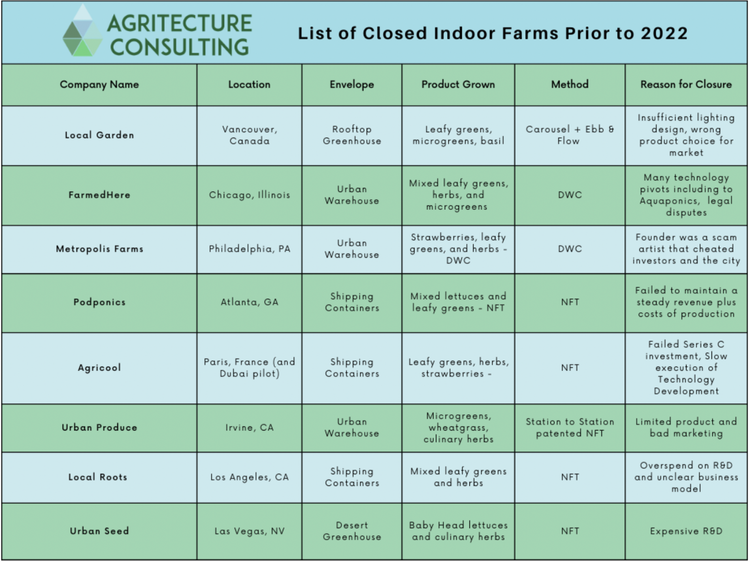The vertical farming sector has recently been going through a period of adjustment. Many are now unsure if vertical farming has a real future after hearing about high-profile farm closures and huge layoffs.
Henry Gordon-Smith, the founder and CEO of Agritecture, predicted that the industry would go through a "trough of disillusionment," or a decline in excitement or profitability, around December 2021. But, this is not altogether a terrible thing because it enables vertical farming to turn around and take a more lucrative trajectory. To prevent making the same mistakes again in the future, it is crucial to learn from the mistakes that are being made right now.
In an effort to steer our readers toward a more lucrative future, we are highlighting 5 common errors that various vertical farms have made.
Read Also : 5 Ways Vertical Farming Is Improving Nutrition
Why then do these vertical farming companies face so many difficulties?
1: Isolating yourself from other industry experts.
Owing to the intense competition in the vertical farming sector, most specialists prefer to keep their techniques and data under wraps. This leads to a lack of teamwork and knowledge-sharing, which is detrimental to business owners as well as the industry as a whole. The creation of innovative methods, tools, and fixes for widespread issues could greatly benefit from collaboration.
2: Not looking at failed vertical farms to see what went wrong.
 |
| List of Closed Indoor Farms Prior to 2022 |
 | |
| List of Q4 2022 Challenged CEA Operations, Europe and U.S.A. (Vertical Farms & Greenhouses) |
Most people have a tendency to ignore failing firms and only focus on successful ones when trying to figure out what made them successful. In reality, there is a wealth of knowledge hidden here that we may learn from the blunders of unsuccessful firms. You can make smarter selections for your own firm by investigating why these failed enterprises choose a particular supplier, location, business style, etc.
3: Failing to collect or analyze information on your farm.
As agricultural technology (AgTech) advances, more and more vertical farms are equipped with sensors and cameras that monitor a variety of factors, including growth rate, plant quality, leaf count, soil moisture and health, and more. Controlled environment farming enterprises can use this data to enhance yields and procedures when monitored and evaluated properly.
The issue here is that despite the enormous amount of data being gathered, very little of it is being applied to boost agricultural output and boost operational effectiveness. On the other hand, a lot of farms don't even attempt to benchmark or measure their performance. Without having the means to demonstrate that their operation satisfies those same data points, many farms go on to make generalized sustainability claims in their marketing and fundraising, fooling both consumers and investors.
4: Failing to forecast and test various business growth scenarios
Business owners are ready to get started. As a result, many people don't spend enough time thinking through all the potential outcomes once they start running their farm.
Director of Operations of Agritecture, Yara Nagi, advises engaging with "other farmers and doing your study to account for those circumstances. Making sure you conduct a climate analysis before selecting your HVAC system is one typical case. Farmers can avoid a lot of headache by thinking ahead in this way.
5: Seeing your farm as individual components rather than as a comprehensive business.
It is vital to plan a vertical farm with the operation's future in mind, from conception and design to growing and harvesting. It is a serious concern to ignore potential problems in the future. For your vertical farm to be successful, it is essential to design an effective farm structure and process. Your crops' yield or productivity are not the issue. It focuses on operational effectiveness and cost containment.
It is challenging for growers to maneuver the grow space to efficiently access and tend to each crop when using standard stacked layers with scissor lifts and several spaced-out rows of product, which wastes time and money.
Here, it's crucial that you weigh your alternatives for farm equipment to make the best decisions for your crops and grow operation.
How can you better get ready for these difficulties?
Agritecture Designer can assist you in navigating the many upcoming hurdles if you are new to vertical farming or in the process of transforming your enterprise.
You may learn more about failed vertical farming ventures and how to prevent them with our Commercial Urban Farming Course. With the help of our farm planning tool, you can better understand which growing system will meet your demands and utilize this information to more accurately project your startup and operating costs. This is essential for assisting you in starting a successful business in your niche.
Additionally, Agritecture's constantly growing Partner Network can put you in touch with reputable equipment suppliers and financial partners who can help your company grow and succeed.
